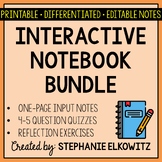Forces and Motion Interactive Notebook Unit | Editable Notes
- Zip
Also included in
- SAVE 30% by purchasing ALL my Physical Science Interactive Notebook Units! EDITABLE Input Notes Included!About this ProductThis differentiated unit bundle includes 13 INB units. Each unit is composed of INB lessons organized into chapters. Each chapter includes:• An overview with photos of the complPrice $105.70Original Price $151.00Save $45.30
- Save 40% by purchasing ALL my Forces and Motion teaching materials!Important Notes:• Download a FREE Unit Bundle to learn more about all my products.• Save $$$ with the Physical Science Complete Curriculum• Save $$$$ with the Integrated Science Complete Curriculum• Consider the Forces and Motion UniPrice $118.80Original Price $195.00Save $76.20
- SAVE 40% by purchasing ALL my PRINTABLE Interactive Notebook Units! EDITABLE Input Notes Included!About this ProductThis differentiated unit bundle includes 47 INB units. Each unit is composed of INB lessons organized into chapters. Each chapter includes:• An overview with photos of the completed INPrice $344.40Original Price $574.00Save $229.60
Description
About this Product
This differentiated unit is composed of interactive notebook lessons organized into chapters. Each chapter includes:
• An overview with photos of the completed INB activity
• One page of input notes (differentiated when necessary)
• At least one INB activity (key included)
• A 4-5 question mini assessment (key included)
• A 2-part reflection exercise
Important Notes:
• Download a FREE Interactive Notebook Unit to learn more about my INB units
• Save $$$ with the Physical Science Complete Curriculum
• Save $$$$ with the Integrated Science Complete Curriculum
*********************************************************************************************************
EDITABLE INPUT NOTES
• 100% one-page EDITABLE copies of input notes are included
• Notes are saved as a single .docx file that opens with Microsoft Word & Google Docs
• Editable notes are written in font compatible with Microsoft Word & Google Docs
*********************************************************************************************************
Topics Covered:
Chapter 1: What is Force?
Chapter 2: Types of Forces
Chapter 3: Applied Force
Chapter 4: Friction
Chapter 5: Gravity
Chapter 6: Weight
Chapter 7: Buoyancy
Chapter 8: Spring Force & Tension
Chapter 9: Balanced & Unbalanced Forces
Chapter 10: Introduction to Motion
Chapter 11: Patterns of Motion
Chapter 12: Net Force & Motion
Chapter 13: Velocity & Acceleration
Chapter 14: Quantifying Force (F=ma)
Chapter 15: Momentum & Inertia
Chapter 16: Newton’s Laws
Chapter 17: Collisions
Chapter 18: Vector vs. Scalar
Additional Info:
-Topics are differentiated for upper elementary and intermediate grades.
-Topics are differentiated with a color and shape code.
-Two pages of generic and self-assessment reflection prompts are included.
-This product does not contain a pure "black diamond chapter."
NGSS Alignment
• This resource supports NGSS 3-PS2-1, 3-PS2-2, 5-PS2-1, MS-PS2-1, MS-PS2-2 and MS-PS2-4.
• Refer to my Free Curriculum Support Materials to help incorporate INB lessons into a NGSS aligned curriculum.
TERMS OF USE
• All rights reserved by Stephanie Elkowitz.
• This product is to be used by the original purchaser only.
• Intended for classroom and personal use only.
• Copying for more than one teacher, classroom, department, school, or school system is prohibited.
• This product may not be distributed or displayed digitally for public view.
• Failure to comply is a copyright infringement and a violation of the Digital Millennium Copyright Act (DMCA).





